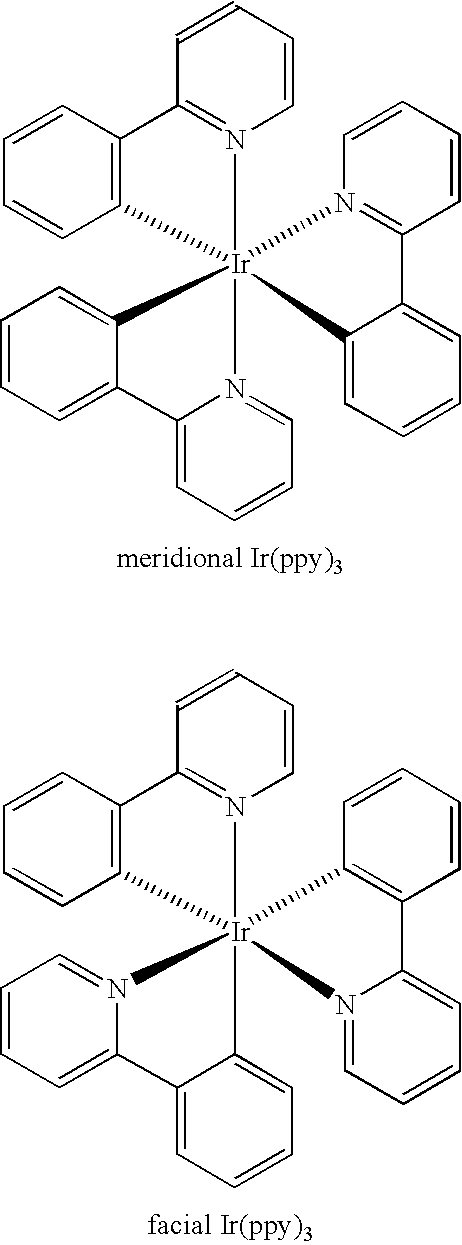Manufacturing process for facial tris-cyclometallated complexes
a triscyclometallic complex and complex technology, applied in the field of manufacturing process of facial triscyclometallic complexes, can solve the problems of difficult synthesis of heteroleptic complexes, severe decomposition, and difficulty in separation and purification of desired compounds, and achieve simple and efficient process, improved purity, and increased ratio to meridional isomers
- Summary
- Abstract
- Description
- Claims
- Application Information
AI Technical Summary
Benefits of technology
Problems solved by technology
Method used
Image
Examples
example 1
[0026] Isomerization of meridional tris-cyclometallated iridium complex, mer-r(piq)2(ppy): A dry flask was charged with mer-Ir(piq)2(ppy) (200 mg, mer / fac ratio >99:1 by HPLC peak area) and anhydrous hexadecane (20 mL). The mixture was stirred under nitrogen atmosphere at ca. 250° C. for 3 hr. After cooling to room temperature, the mixture was diluted with heptane and the crude product was collected by filtration. The crude materials contained 93.9% (by HPLC peak area) fac-Ir(1-piq)2(ppy), 4.3% mer-Ir(1-piq)2(ppy), and ˜1% of ligand scrambling by-products. The crude materials were dissolved in dichloromethane and filtered through a silica gel plug and washed with dichloromethane. The filtrate was concentrated and the productfac-Ir(l-piq)2(ppy) was precipitated by addition of heptane, to yield 133 mg, 66%, >95% isomeric purity.
example 2
[0027] Isomerization of meridional tris-cyclometallated iridium complex, mer-Ir(piq)2(ppy): A dry flask was charged with mer-Ir(piq)2(ppy) (400 mg, merlfac ratio >99:1 by HPLC peak area) and anhydrous tetradecane (20 mL). The mixture was refluxed under nitrogen atmosphere for 2 h. After cooling to room temperature, the mixture was diluted with heptane and filtered. The crude material contained 97% (by HPLC peak area)fac-Ir(1-piq)2(ppy) and 3% mer-Ir(1-piq)2(ppy). The crude materials was dissolved in dichloromethane and filtered through a silica gel plug and washed with dichloromethane. The filtrate was concentrated and the product fac-Ir(1-piq)2(ppy) was precipitated by addition of methanol, 328 mg, 82%, >97% isomeric purity.
example 3
[0028] Isomerization of meridional tris-cyclometallated iridium complex, mer-Ir(piq)2(ppy): A dry flask was charged with mer-Ir(piq)2(ppy) (100 mg, mer / fac ratio >99:1 by HPLC peak area) and 1-tetradecene (tech. 92%, Aldrich, 10 mL). The mixture was refluxed under nitrogen atmosphere for 1.5 h. After cooling to room temperature, the mixture was diluted with heptane. The red solids were collected by filtration and washed with heptane and dried in air, to yield 78 mg, 78%, >99% isomeric purity.
PUM
| Property | Measurement | Unit |
|---|---|---|
| temperature | aaaaa | aaaaa |
| temperature | aaaaa | aaaaa |
| temperature | aaaaa | aaaaa |
Abstract
Description
Claims
Application Information
 Login to View More
Login to View More - R&D
- Intellectual Property
- Life Sciences
- Materials
- Tech Scout
- Unparalleled Data Quality
- Higher Quality Content
- 60% Fewer Hallucinations
Browse by: Latest US Patents, China's latest patents, Technical Efficacy Thesaurus, Application Domain, Technology Topic, Popular Technical Reports.
© 2025 PatSnap. All rights reserved.Legal|Privacy policy|Modern Slavery Act Transparency Statement|Sitemap|About US| Contact US: help@patsnap.com



